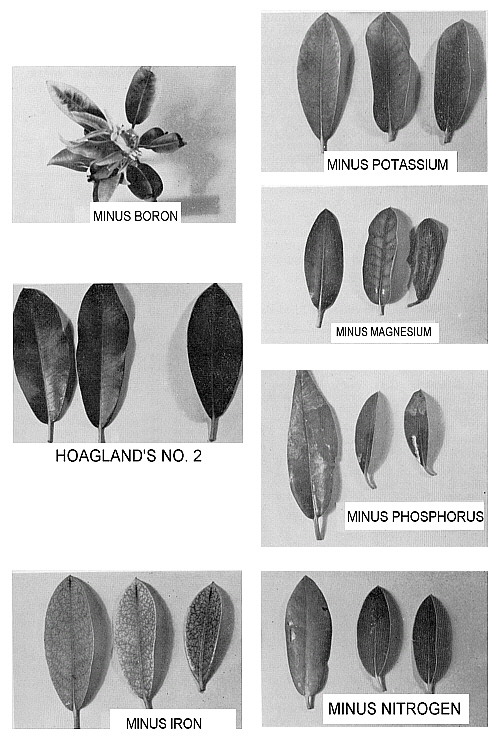QBARS - v24n2 Deficiency Symptoms Studied
Deficiency Symptoms of Rhododendron Studied
C. R. Johnson and A. N. Roberts
Dept. of Horticulture, Oregon State University
Reprinted from Oregon Ornamental & Nursery Digest
Rhododendron leaves often show cholorsis. However, diagnosis of causes have been difficult because the literature lacks descriptive symptomatology. Various nutrient deficiency symptoms were developed in Rhododendron 'Cynthia' and 'Pink Pearl' to supply this information. Rooted cuttings were grown in sand cultures containing complete Hoagland's solutions (Nos. 1 and 2), or minus one of the following from Hoagland's No. 1: nitrogen, potassium, phosphorus, magnesium, sulfur, calcium, iron, boron, or manganese.
Deficiency symptoms were produced on plants from the various nutrient cultures in a three- to nine-month period and are discussed in the order of their appearance. Leaf symptoms and composition values were similar for both cultivars; therefore, the results presented are applicable to both 'Cynthia' and 'Pink Pearl'.
Leaves from plants receiving the nitrate form of nitrogen (complete Hoagland's No. 1) were smaller and had slight interveinal chlorosis compared to those receiving the ammonium form (complete Hoagland's No. 2). Thus, as found by Colgrove with azaleas, the ammonium form of nitrogen also produces healthier appearing foliage in rhododendron.
Nitrogen malnutrition visible
Nitrogen malnutrition was visible three months after planting, and the plants were stunted in growth. All the leaves were uniformly light green in color and dwarfed. Phosphorous-deficient plants were stunted and had leaves that were smaller and darker green in color than normal. The tips of such leaves became necrotic, and this condition spread over the entire surface causing premature defoliation. Stunted and contorted multiple shoots developed at the apex of shoots deficient in boron. The stunted leaves also showed marginal yellowing and tip scorching. Calcium deficiency was observed after five to six months, although the new shoot growth was visibly stunted about two to three months earlier. The tips of calcium deficient leaves became scorched and shriveled, with the basal portion remaining dark green.
There were no significant reductions in growth with other nutrient-deficient cultures. Iron deficiency was apparent four to five months after planting. Young leaves were initially pale yellow, but older ones developed distinct interveinal chlorosis and the whole plant eventually became chlorotic. Severe interveinal yellowing developed in the centers of leaves deficient in magnesium when the plants were about five months old. These areas became necrotic and the leaves dropped prematurely. Potassium deficiency was first evident as an orange mottle along the margins of older leaves that later became necrotic causing premature defoliation. The last deficiency symptom to develop (9 months) was that of sulfur. After two or three flushes of new growth, the youngest leaves were pale green. All leaves were eventually lighter green than normal, but they developed no other distinct symptoms. Even though the level of manganese in leaf tissue was low compared to other cultures, there was no visible evidence of deficiency. Apparently the rhododendron can continue normal growth on very low levels of this element.
Leaf samples of both cultivars were collected from the plants as the symptoms of nutrient deficiency developed. Leaf analyses were then made to indicate approximate threshold levels of the various elements. The mineral composition values are an average of both cultivars and appear in Table 1. Pictures with brief descriptions of some of the various nutrient-deficiency symptoms appear in the accompanying figure.

|
|
Table 1: Mineral composition of Rhododendron 'Cynthia' and 'Pink Pearl' leaves
at first visible symptoms of deficiency. |
|||||||
| Nutrient solution | N | P | K | Ca | Mg | B | Mn |
| percent dry weight | ppm | ppm | |||||
| Complete Hoagland's No. 2 | 2.65 | 0.346 | 3.08 | 0.99 | 0.302 | 45.7 | 75 |
| Complete Hoagland's No. 1 | 2.43 | 0.312 | 2.95 | 1.10 | 0.292 | 54.0 | 70 |
| Minus N* | 1.00 | 0.451 | 2.72 | 0.86 | 0.212 | 59.0 | 108 |
| Minus P | 2.76 | 0.110 | 3.40 | 1.21 | 0.165 | 86.5 | 115 |
| Minus K | 3.12 | 0.465 | 0.30 | 1.25 | 0.202 | 77.8 | 75 |
| Minus Ca | 2.41 | 0.337 | 3.13 | 0.14 | 0.293 | 66.0 | 51 |
| Minus Mg | 2.57 | 0.517 | 3.05 | 1.32 | 0.039 | 64.5 | 58 |
| Minus S | 2.51 | 0.510 | 3.89 | 0.89 | 0.269 | 55.7 | 77 |
| Minus Fe | 2.75 | 0.517 | 3.21 | 0.84 | 0.201 | 58.2 | 80 |
| Minus B | 2.77 | 0.438 | 3.08 | 1.18 | 0.212 | 14.6 | 59 |
| Minus Mn | 2.46 | 0.320 | 2.20 | 1.05 | 0.205 | 49.5 | 8 |
| *Deletion from Hoagland's No. 1, solution. | |||||||
